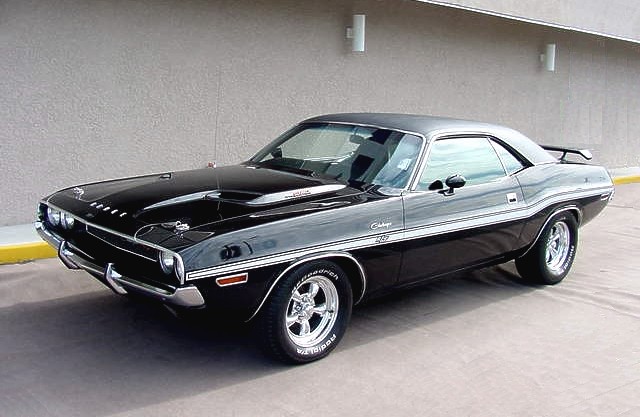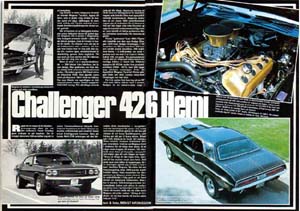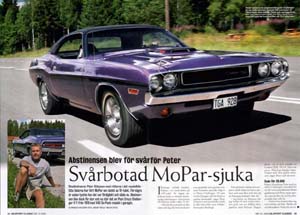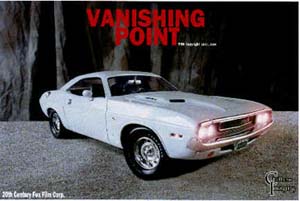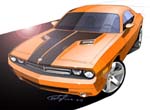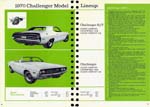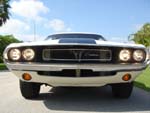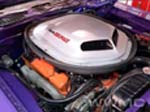|
Tillverkningen 1970-1974
1970 Dodge Challenger
Comments: The Dodge Challenger was based on the Plymouth Barracuda platform,
but its
wheelbase was stretched by two inches to provide more interior room. The
Challenger was
offered in both hardtop and convertible versions. Performance versions
wore the R/T (Road/Track)
badge and either the base or R/T model could be ordered with the SE luxury
package. The SE
package included leather seats and a vinyl roof with a smaller "formal"
rear window.
Challenger R/T's came standard with the 335 bhp 383 engine. Optional were
two 440 engines,
the four-barrel Magnum with 375 bhp and the tri-carb Six Pack with 390
bhp (chosen by 2,035 buyers).
Topping the list was the almighty 426 Hemi with 425 bhp (chosen by 356
buyers).
The Hemi cost an additional $1,228 and required heavy-duty equipment.
The 440s and the Hemi came standard with TorqueFlite automatic.
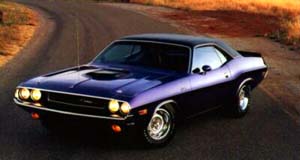
Optional was a four speed manual which included a pistol-grip Hurst shifter
and a Dana 60 axle.
Gear axles climed from 3.23:1 to 4.10:1, with limited slip as an option.
All R/Ts received a heavy duty suspension and the 440s and Hemi received
15 inch 60 series tires,
although essentials such as power steering and front disc brakes were
still optional.
The R/T's standard hood had two hood scoops, but they did not feed directly
into the air cleaner.
For just $97, the buyer could specify the shaker scoop, which mounted
to the air cleaner and stuck
up through an opening in the hood. It was known as the "shaker"
as it vibrated along with the engine.
Some faults of the Challenger included poor outward visibility and it
feeling too bulky for its size.
But Dodge had one more trick up its sleeze. In order to race in the Sports
Car Club of America's Trans
American Sedan Championship, it built a street version of its race car
(just like Plymouth with its
Plymouth 'Cuda AAR) which it called the Dodge Challenger T/A (Trans Am).
Although the race cars ran a
destroked version of the 340, street versions took the 340 and added a
trio of two-barrel carbs atop an
Edelbrock aluminum intake manifold, creating the 340 Six Pack. Dodge rated
at the 340 Six Pack at the
same 290 bhp rating as the original 340 engine (and mysteriously the same
rating as the Camaro Z/28 and
Ford Boss 302 Mustang), it actually made about 350 bhp. It breathed air
through a suitcase sized air
scoop molded into the pinned down, lift off matte-black fiberglass hood.
Low-restriction dual exhausts
ran to the stock muffler location under the trunk, then reversed direction
to exit in chrome tipped
"megaphone" outlets in front of the rear wheels. TorqueFlite
automatic or Hurst-shifted four-speed
transmission, 3.55:1 or 3.90:1 gears, manual or power steering were available.
Front disc brakes were
standard. The special Rallye suspension used heavy duty parts and increased
the camber of the rear springs.
The T/A was among the first production vehicles to use different size
tires front and rear: E60x15 fronts,
and G60x15 in back. The modified camber elevated the tail enough to clear
the rear rubber and its side
exhaust outlets, thick side stripes, bold ID graphics, and a ducktail
spoiler added to the street punk image.
The interior was strictly stock Challenger. Unfortunately, the race Challenger
T/A wasn't very competitive
and the street version suffered from severe understeer in fast corners.
But it could turn mid 14s in the
quarter mile which would do any small block muscle car proud. The T/A
would only be available for 1970 as
Dodge would pull out of Trans Am racing.
Production:
Challenger Base: 53,337
Challenger T/A: 2,142
Challenger R/T Coupe: 12,747
Challenger R/T Convertible: 1,070
Challenger RT/SE Coupe: 3,679
Engines:
225 I6 145 bhp.
340 V8 275 bhp @ 5000 rpm, 340 lb-ft @ 3200 rpm.
T/A: 340+6 V8 290 bhp @ 5000 rpm, 345 lb-ft @ 3400 rpm.
383 V8 330 bhp.
426 Hemi V8 425 bhp @ 5000 rpm, 490 lb-ft @ 4000 rpm.
440 V8 375 bhp @ 4600 rpm, 480 lb-ft @ 3200 rpm.
440+6 V8 390 bhp @ 4600 rpm, 480 lb-ft @ 2300 rpm.
Performance:
T/A: 0-60 in 5.9 seconds, 1/4 mile in 14.5 seconds @ 99.6 mph.
R/T 440-6: 0-60 in 6.2 seconds, 1/4 mile in 13.7 seconds @ 105 mph.
1971 Dodge Challenger
Comments: For 1971, the Dodge Challenger received a new grille and several other
changes from 1970.
The Challenger T/A was advertised but never made and was officially dropped
(as Dodge had withdrawn
from Trans Am racing). The R/T convertible was also dropped and the SE package
was only available on
base model Challengers. The R/T for 1971 had color-keyed bumpers, dummy brake
cooling slots on its rear
flanks, and new tape stripes. The 383 engine was still standard on R/T models,
but it was detuned to
300 bhp due to a lower compression ratio to meet new government regulations.
The base 440 was dropped,
but the 440-6, rated at 385 bhp (down 5 bhp from 1970) and the Hemi, still rated
at 425 bhp were still
available. But that didn't stop a severe sales slide as sales fell 60% in just
the Challenger's second year.
A small group of Dodge dealers tried to boost Challenger sales in 1971 by providing
50 specially prepared
examples as official and pace cars for the Indianapolis 500 race. All of these
cars were Hemi Orange convertibles
with white interior, although just two had high-performance options. One --
the pace car -- skidded and crashed
into a press box, injuring a number of reporters. Not surprisingly, the pace
car decal sets available through
Dodge dealers did not sell well.
Production:
Challenger Base: 23,088
Challenger Base Convertible: 2,165
Challenger R/T Coupe: 4,630
Challenger R/T Convertible: ?
Challenger RT/SE Coupe: ?
Engines:
225 I6 145 bhp.
318 V8 230 bhp.
340 V8 275 bhp @ 5000 rpm, 340 lb-ft @ 3200 rpm.
T/A: 340+6 V8 290 bhp @ 5000 rpm, 345 lb-ft @ 3400 rpm.
383 V8 300 bhp.
426 Hemi V8 425 bhp @ 5000 rpm, 490 lb-ft @ 4000 rpm.
440 V8 375 bhp.
440+6 V8 385 bhp @ 4600 rpm, 480 lb-ft @ 2300 rpm.
Performance:
T/A: 0-60 in 5.9 seconds, 1/4 mile in 14.5 seconds @ 99.6 mph.
R/T 440-6: 0-60 in 6.2 seconds, 1/4 mile in 13.7 seconds @ 105 mph.
1972 Dodge Challenger
Comments: The 1972 Challenger gained new front end styling which included a
new eggcrate grille which had downturned ends.
Critics noted that it was showing a sad face to its own emasculation. The R/T
performance version was dropped and
convertibles were eliminated. The 440 and Hemi were also dropped. A new Rallye
edition replaced the R/T model, but sported
only a 318 with just 150 bhp (net). The largest engine available was a 340 with
just 240 bhp (net), a far cry from just the year before.
Production:
Challenger Base: 18,535
Challenger Rallye Coupe: 8,123
Engines:
318 V8 150 bhp.(SAE Net)
340 V8 240 bhp. (SAE Net)
Performance:
340/240: 0-60 in 8.5 seconds, 1/4 mile in 16 seconds.
Production: Engines: 318 V8 150 bhp. 340 V8 240 bhp.
Performance:
****
1973 Dodge Challenger
Comments: The Dodge Challenger continued its downward slide for 1973. The Rallye
edition was dropped, although buyers could still build their own on the option sheet. Sales were still up for the year,
even though most of these cars had the 318
with 150 bhp, hardly a performance machine. Still available was the 340 with
240 bhp but it was replaced at mid-season
with a new 360 V8 debuted with 245 bhp. The increased capacity was the only
way that Dodge could keep power up in the face
of tightening emissions control regulations.
Production: 32,596
Engines:
318 V8 150 bhp.(SAE Net)
340 V8 240 bhp. (SAE Net)
360 V8 245 bhp. (SAE Net)
Performance:
N/A
1974 Dodge Challenger
Comments: 1974 would be the last year for the Dodge Challenger, still available
with the 360 for those that wanted any real
performance. The Dodge Challenger lived just five short years, but it made its
mark on the muscle car era.
Production: 16,437
Engines:
318 V8 150 bhp.(SAE Net)
360 V8 245 bhp. (SAE Net)
Performance:
N/A
|
